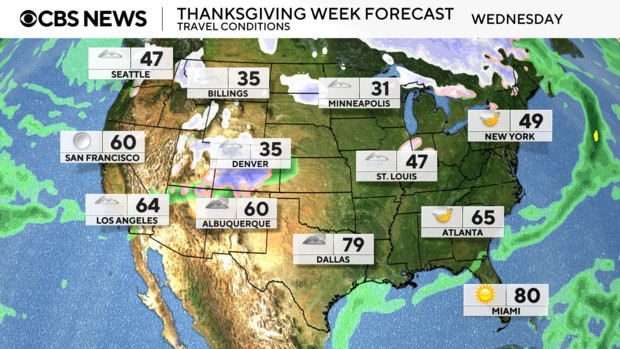Thanksgiving travel across the United States is facing significant disruptions as a messy winter storm sweeps through various regions. Travelers should be prepared for potential delays and hazardous conditions as the storm system brings a mix of snow, rain, and sleet to the eastern parts of the country, the Mountain West, and the Midwest. The holiday period, already anticipated to be one of the busiest for travel, is now complicated by this widespread weather event.
 Nikki Nolan of CBS News delivering a weather forecast on Wednesday, displayed on a television screen, indicating potential winter storm impacts across the US for Thanksgiving.
Nikki Nolan of CBS News delivering a weather forecast on Wednesday, displayed on a television screen, indicating potential winter storm impacts across the US for Thanksgiving.
Thanksgiving Day Storm Impacts Across the Northeast
The winter storm, which caused earlier disruptions in western states, moved eastward as predicted, arriving on Thanksgiving Day and bringing heavy snowfall to the interior Northeast. Upstate New York experienced significant snowfall, with some areas recording over half a foot of snow by mid-morning, according to the National Weather Service. Meteorologist Nikki Nolan of CBS News reported that a mix of rain, snow, and sleet was expected throughout Thanksgiving Day across most of the Northeast. While the Interstate 95 corridor was predicted to mainly see rain, areas further inland were bracing for substantial snowfall. Despite the inclement weather forecast in New York City, the Macy’s Thanksgiving Day Parade proceeded as planned, with attendees equipped with rain gear to enjoy the festivities. The storm was expected to intensify throughout Thursday, with forecasts predicting 1 to 3 inches of rain for the Northeast and 5 to 10 inches of snow in certain areas extending into Sunday. The Great Lakes region is anticipating even heavier snowfall, potentially reaching up to 2 feet.
Travel Warnings and Winter Weather Advisories in Effect
Winter storm warnings, storm watches, and weather advisories were active across the interior Northeast and parts of the Midwest on Thanksgiving. These alerts are expected to remain in place through the weekend, potentially causing prolonged travel disruptions. Forecasters warned that regions in Maine and New Hampshire could receive up to 10 inches of snow between Thursday and Friday, significantly impacting travel conditions. The National Weather Service office in Gray, Maine, urged individuals to postpone travel if possible, emphasizing the need for extreme caution for essential travel. Their advisory included recommendations for safe driving practices in winter conditions, such as increasing following distance, allowing extra travel time, and avoiding sudden braking. Beyond snow and ice, temperatures are also dropping across much of the US, with Minneapolis and other northern locations preparing for severely cold weather. Interestingly, while the Southeast was initially expected to avoid the cold, a cold front associated with the winter storm is now posing a threat of tornadoes, damaging winds, and large hail to the region.
Specific Areas Facing Hazardous Travel Conditions
Winter weather advisories are specifically impacting northern Michigan, where the National Weather Service in Marquette cautioned about the potential for up to 13 inches of additional snowfall over the coming days. These advisories are in effect until Sunday morning, explicitly warning that “Travel could be very difficult to impossible at times” and that “The hazardous conditions will impact Thanksgiving holiday travel.” Similarly, upstate New York is under winter storm warnings, with Buffalo forecasters predicting up to a foot of snow, which could disrupt travel plans. Northern Michigan is also expecting up to 7 inches of snow, leading to forecasts of slippery roads and hazardous driving conditions on Friday. Travelers in these regions should be aware of the increased risks and potential for significant delays.
Record Thanksgiving Travel Volume Meets Winter Storm Challenge
This winter storm is occurring during what is projected to be a record-breaking Thanksgiving travel period. AAA estimates indicated that 80 million people were expected to travel at least 50 miles over the seven-day holiday period starting Tuesday. This unprecedented travel volume, combined with the widespread winter weather, is creating significant challenges for travelers. The major storm system, linked to an atmospheric river originating in the West, is affecting a vast area from the Rocky Mountains to the East Coast, exacerbating holiday travel congestion. Transportation correspondent Kris Van Cleave of CBS News reported from LaGuardia Airport on Tuesday, highlighting the widespread impact on air travel. He noted that airports from San Francisco to Las Vegas, Salt Lake City, Denver, and across the Northeast from Washington D.C. to Boston, could all experience delays due to the multiple storm systems. The Federal Aviation Administration scheduled 50,000 flights on Tuesday alone, with expectations of even higher volumes on Wednesday and Sunday, making potential weather-related delays even more impactful.
Snowfall Expected Across Northern Regions
Forecasters indicate that below-average temperatures, particularly in the interior Northeast and Northern Plains, will be a key factor in determining whether precipitation falls as rain or snow in specific locations. Arctic air is settling over the western two-thirds of the country, contributing to the wintry conditions. Earlier in the week, heavy snow had already fallen across the southern Sierra Nevada, Intermountain West, and Central Rockies. The Weather Prediction Center anticipates snow showers to continue across the Great Lakes and into the Northeast. As temperatures dropped in the Northern Plains leading up to Thanksgiving, a series of weather disturbances are facilitating an arctic outbreak across the region, ensuring that winter weather will be a significant factor for Thanksgiving travelers in numerous US states.
While the main storm system is expected to move out after the holiday, lake-effect snow showers are forecast to persist in the Northeast through the weekend, meaning travel conditions may remain challenging even after Thanksgiving Day itself. Travelers are advised to stay updated on weather forecasts, heed travel advisories, and exercise extreme caution if travel is necessary during this winter storm.

